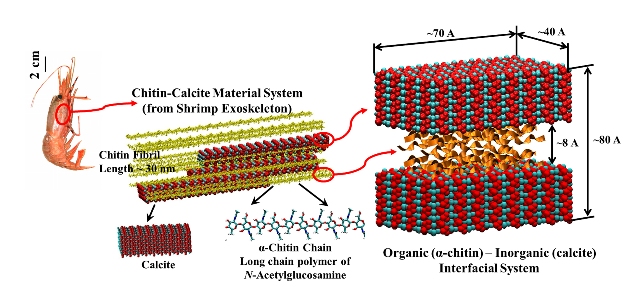Jul 16 2015
 This graphic depicts the exoskeleton structure of a certain type of deep-sea shrimp able to survive the scalding hot waters of hydrothermal vents thousands of feet under water. Insights into the complex molecular behavior of the materials could have implications for the design of new synthetic armor capable of withstanding environmental extremes. (Credit: Purdue University photo/Tao Qu)
This graphic depicts the exoskeleton structure of a certain type of deep-sea shrimp able to survive the scalding hot waters of hydrothermal vents thousands of feet under water. Insights into the complex molecular behavior of the materials could have implications for the design of new synthetic armor capable of withstanding environmental extremes. (Credit: Purdue University photo/Tao Qu)
Researchers from Purdue University's School of Aeronautics and Astronautics are involved in studying the exoskeletons of certain species of shrimps to understand how they are able to withstand very hot waters in hydrothermal vents several thousands of feet under the sea.
“A biological species surviving in that kind of extreme environment is a big deal,” said Vikas Tomar, an associate professor in Purdue University's School of Aeronautics and Astronautics. “And shrimp are a great test case for evolution because you can find different species all over the world living at various depths and with a range of adaptation requirements.”
Tomar along with doctoral students Tao Qu, Devendra Verma, Yang Zhang and Chandra Prakash compared the exoskeletons of two species of shrimps - the shallow-dwelling shrimp Pandalus platyceros and the deep-sea shrimp Rimicaris exoculata.
The Pandalus platyceros lives just below the ocean surface, while the Rimicaris exoculata lives in volcanic hydrothermal vents 2,000m below the ocean surface, where temperatures can rise above 400°C.
“We want to understand how evolution affects material behavior in the exoskeletons of these two shrimp species that thrive in far different conditions,” Tomar said.
Their research could provide insight into the intricate molecular behavior of the materials, which in turn could have an impact on the design of novel synthetic armor with the ability to handle extreme environmental conditions.
Latest findings have been published online on July 2 in the form of a research paper. Subsequently the paper will also be printed in the journal Acta Biomaterialia. The researchers have also published two other recent papers dealing with laboratory experiments conducted on the shrimp exoskeletons.
The Purdue researchers examined the interface between two main parts of the exoskeletons - a bone-like mineral, calcite and a protein known as chitin. The behavior of these materials – one inorganic and the other organic, at their interface was observed, which is key to determining the performance of the exoskeletons.
The team chose to study 10 exoskeleton specimens and conducted various laboratory tests using scanning electron microscopy and electron diffraction spectroscopy, which provided useful information regarding their chemical composition and structure.
The exoskeletons of the shrimps consisted of the same microstructures – the calcite, chitin and other components, in the form of a layered helicoidal structure similar to a spiral staircase. When compared, differences in the mineral content, density of the structures and thickness of the layers were noticed.
The exoskeleton of the deep-sea shrimp possessed a very densely packed structure. However to the amazement of the researchers, the strength of the exoskeleton of the surface shrimp was 10 times higher than that of the deep-sea shrimp.
“Mechanistically, you would expect that when it is compacted it becomes stronger, but it is actually weaker after compaction,” Tomar said.
The latest research studied the activities at the interface between the calcite and chitin as well as how these mechanisms affected the performance of the exoskeleton. This interface aided the researchers in establishing the way in which these structures transferred stress.
The research also showed that the deep-sea shrimp’s exoskeleton was softer but still capable of managing extreme temperature and pressure. On the other hand, the surface shrimp’s exoskeleton was harder, thereby acting as a better protection against predators.
“Even though they have the same basic microstructure, they are completely different materials,” Tomar said.
The findings relating to the interface viscosity procured using molecular simulations of the interacting materials helps to create highly accurate models of polymer-ceramic composites deformation caused by strain.
The team formulated a “viscoplastic law,” or mathematical equations for this type of an interface.
Traditional models for polymer-ceramic composites are not up to the mark as they focus only on peak strength, while the materials tend to fail due to high strain or when stretched.
“There are failure theories that we use, but they predict the failures in terms of strength,” Tomar said. “In the case of these materials it is the strain that’s most important, so you cannot exceed a certain level of deformation without breaking.”
The study reveals that water favorably impacts the molecular structure of the exoskeletons by providing it strength.
The researchers developed an “interface database” to represent how the performance of a specific composite material will be, for a specific microstructure, composition, and interface type.
Milad Alucozai, Purdue undergraduate student also authored the Acta Biomaterialia paper. He has been selected as one of 12 U.S. students to receive the nationally prestigious Mitchell Scholarship for graduate study in Ireland. Alucozai is Purdue’s first Mitchell Scholarship recipient.
In an associated research, the Purdue team is partnering with researchers at the Vienna University of Technology to analyze the interface between human bone and collagen and the ways in which the bone deforms after a while. The research was published in April in the Materials Research Society Bulletin, and its findings could assist in creating improved medical implants.
The Purdue research was funded by the National Science Foundation (grant CMMI-1131112).